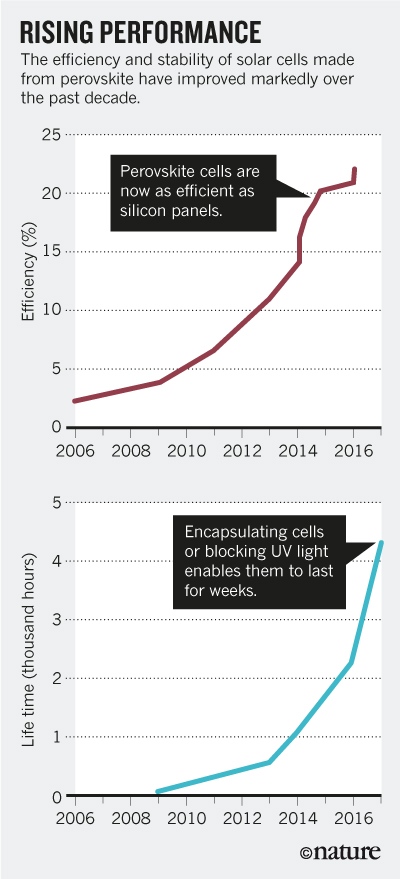Organic/inorganic hybrid perovskite cells have the advantages of low cost, low temperature flexibility, and ease of printing over large areas, and have attracted widespread attention. In the past decade, the research of perovskite batteries has developed rapidly, and its photoelectric conversion efficiency has rapidly increased from the initial 2.2% to 22.1% (Fig. 1), which is close to that of silicon solar cells. Large area batteries have also developed rapidly (Figure 2). Therefore, perovskite solar cells have a huge development prospect.
The main reason for the commercial application of perovskite batteries is the stability of their batteries. Currently perovskite batteries can only work for a few months under the conditions of service (Fig. 1), while conventional silicon batteries can work for more than 25 years. Therefore, how to improve the stability of perovskite batteries is the most important issue in this field. Scientists from all over the world are competing to work in this area. At the invitation of Nature, Yang Yang, a professor at the University of California, Los Angeles, and Researcher You Jingbi from the Institute of Semiconductors, Chinese Academy of Sciences, recently wrote a review article titled Make perovskite solar cells stable (Yang Yang, Jingbi You, Nature, 544, 155-156 (2017)).
In view of the current research progress, they summarized five methods to improve the stability of perovskite solar cells: 1) Regulate the crystal structure of perovskite materials, and increase the phase stability of perovskite materials through a small amount of doping; 2) Reduce perovskite crystal defects, reduce permeation channels in the external environment; 3) Design new stable perovskite materials; 4) Use stable inorganic charge transport layers; 5) Improve packaging processes. At the same time, they called for more funds and human resources to participate in the work of improving stability; theoretical physicists, material chemists, and device engineers should work closely together to develop and develop new stable perovskite-based solar materials and Devices. In addition, researchers must adopt uniform stability testing standards when reporting device stability. Only in this way can we accelerate the commercialization of perovskite batteries for people to use.
Yang Yang and You Jingbi are the co-corresponding authors of the review article.

Figure 1. (Top) Trends in the development of perovskite cells over the past decade, (bottom) Perovskite battery stability development charts.

Figure 2. Large area perovskite solar cell
Roller Cutters,Cone Cutter Drill Bits,Cone Cutters,Roller Cone Cutters
CANGZHOU GREAT DRILL BITS CO., LTD , https://www.pdcbits.nl
